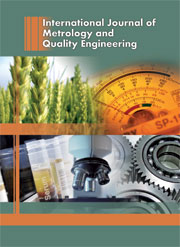Article contents
Precision grating for measuring microscope lensdistortions
Published online by Cambridge University Press: 17 December 2010
Abstract
Microscopy is used in most technology processes where two-dimensional distributions, thatare digital images of the shape and appearance of integrated circuit (IC) features, revealimportant information. Optical microscopy and diffraction gratings can be used to measurethe placement of IC features with a precision of less than 1 nm (1σ) witha new technique of separately viewing multiple levels. However, the microscope’s opticaland video camera distortion may cause significant errors in the IC feature measurementunder some circumstances. In this paper, the optical and video camera distortions of anoptical microscope used in IC feature measurement were studied by analyzing digital imagesof a precision grating. MATLAB programs were used to extract the value of intensity ofeach pixel in the grating image. By matching a position dependent, phase-varied idealsinusoidal wave to the processed grating digital image, the phase of the best-fit sinewave was observed to vary by the equivalent of many nanometers at different locationswithin the digital image of the grating. This variation was similar, but significantlydifferent, for different microscope objectives. It is believed to arise from opticaldistortion within the microscope, and possibly also from distortion within the camera.Impact of optic chromatic aberration and microscope stability on the measurement of ICfeatures was also studied. The method described here is inexpensive and easy to implementsince it does not require any sophisticated equipment or controlled environment. Thistechnique provides an attractive option for small companies, university labs andinstrument manufacturers.
Information
- Type
- Research Article
- Information
- International Journal of Metrology and Quality Engineering , Volume 1 , Issue 2 , 2010 , pp. 83 - 88
- Copyright
- © EDP Sciences 2010
References
Références
- 1
- Cited by

